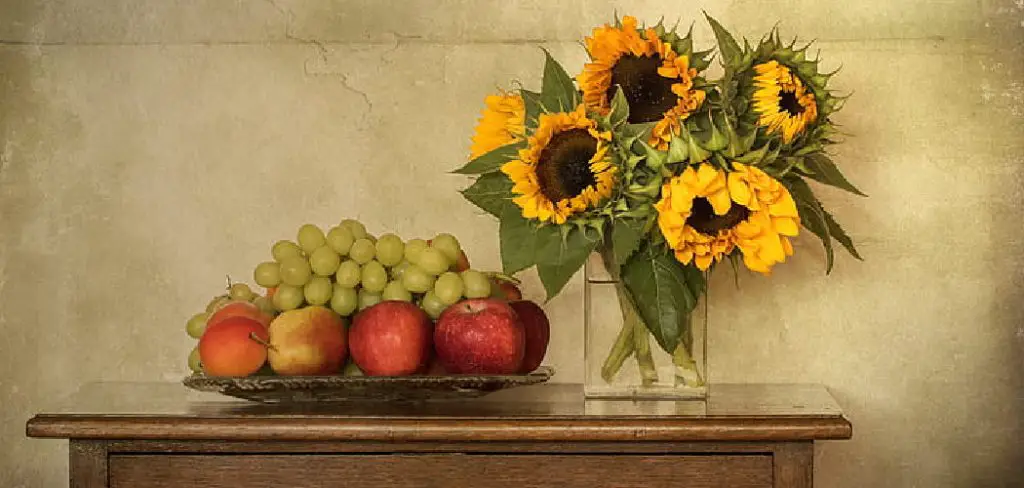Sunflowers, with their vibrant yellow petals and cheerful appearance, are a popular choice for floral arrangements that exude warmth and radiance. However, arranging sunflowers effectively involves more than just placing them in a vase.
To create a stunning sunflower arrangement that showcases their beauty and charm, one needs to consider factors like vase selection, complementary flowers, and proper care.

In this article, we will guide you through the art of arranging sunflowers, offering expert tips on selecting the right container, choosing suitable accompanying blooms, arranging the sunflowers to maximize their visual impact, and maintaining the arrangement’s freshness.
Whether you’re preparing a bouquet for a special occasion or looking to add a touch of sunshine to your home, learning how to arrange sunflowers will help you create striking and inviting floral displays that capture the essence of these beloved flowers.
The Purpose of Arranging Sunflowers
Sunflowers are popular flowers that are known for their bright yellow petals and large size. They are often used in floral arrangements for their vibrant color, long stem, and unique appearance. However, arranging sunflowers can be a bit tricky due to their large size and heavy heads.
The purpose of arranging sunflowers is not only to enhance their natural beauty but also to ensure that they last longer in a floral arrangement. Properly arranging sunflowers will not only make them look visually appealing but also help them to stay fresh for a longer period of time.
Considering the Size and Quantity of Sunflowers
As a general rule of thumb, sunflowers are one of the most popular and iconic flowers known for their vibrant yellow color and large size. While they can brighten up any room or garden with their presence, arranging them requires some thought and planning.

The first thing to consider when arranging sunflowers is their size and quantity. Sunflowers come in different sizes ranging from small to large, with the average size being around 12 inches in diameter.
So before you begin arranging, it is important to know how many sunflowers you want to use and their sizes. This will help you determine the scale of your arrangement and give you a better idea of how much space they will take up.
Another factor to consider when working with sunflowers is their sturdy stems. Sunflowers have strong and thick stems that can hold up their large heads, making them ideal for tall arrangements.
However, this also means that you will need a sturdy vase or container to support the weight of the flowers. Depending on the size and quantity of sunflowers you are using, choose a container that is both aesthetic and practical.
10 Steps How to Arrange Sunflowers
Step 1: Gather Your Materials
Before you begin, ensure you have all the necessary materials and tools ready. You’ll need:
- Sunflowers: Choose fresh sunflowers with sturdy stems and vibrant blooms.
- Vase: Select an appropriate vase that complements the size and style of your arrangement.
- Flower Food: Prepare a solution of flower food and water to keep the sunflowers fresh.
- Pruners or Scissors: These are essential for cutting and trimming stems.
- Greenery or Filler Flowers: Consider adding greenery like eucalyptus, or filler flowers such as baby’s breath, to complement the sunflowers.
Step 2: Select Your Sunflowers
When choosing sunflowers for your arrangement, look for those with strong, straight stems and fresh, healthy blooms. Opt for sunflowers at different stages of maturity to add depth and interest to your arrangement.

You can mix fully open sunflowers with some that are still in bud form. This will also extend the life of your arrangement, as the buds will continue to open over time.
Step 3: Prepare Your Vase
Ensure your vase is clean and free of any residue that could promote bacterial growth. Fill the vase with water and add the appropriate amount of flower food according to the package instructions. This will help keep the sunflowers fresh and vibrant for a longer period. If you do not have flower food, you can make your own by mixing 1 quart of water with a teaspoon of sugar and a few drops of bleach.
Step 4: Trim and Prepare the Sunflower Stems
Using pruners or sharp scissors, trim the sunflower stems at an angle. The angle allows the stems to absorb more water, keeping the flowers hydrated. Be cautious not to crush or split the stems while cutting.
Remove any leaves that would be submerged in the water, as they can promote bacterial growth. Although some may prefer to leave the leaves for a more natural look, doing so can decrease the longevity of your sunflowers.
Step 5: Start with the Centerpiece
Begin your arrangement by selecting the sunflower that will be the centerpiece. This sunflower should be slightly taller or have a larger bloom than the others. Place it in the center of the vase. To keep it secure, you can use floral foam or a small amount of clear tape on the bottom of the stem.
Step 6: Create the Foundation
Surround the centerpiece sunflower with filler flowers or greenery. These elements will act as the foundation for your arrangement, providing a backdrop for the sunflowers. Consider using greenery like eucalyptus or filler flowers such as baby’s breath to add texture and volume. Place these elements in a circular pattern around the sunflower, making sure they are evenly distributed and balanced.

Step 7: Add Sunflowers Gradually
Start adding the remaining sunflowers one by one, working from the center outward. Gradually build the arrangement by placing sunflowers of varying heights and bloom sizes to create a visually appealing composition. The variety in height and size will give your arrangement a more natural and dynamic look.
Ensure that each sunflower is placed at a slightly different angle to add depth and dimension to the arrangement. You can also intersperse some greenery or other filler flowers like baby’s breath to complement the bright yellow sunflowers.
Step 8: Adjust and Balance
As you add sunflowers, step back and assess your arrangement. Make any necessary adjustments to ensure that the sunflowers are evenly distributed and the arrangement appears balanced from all angles.
Check the height and positioning of each sunflower to maintain a harmonious look. While some sunflowers may naturally lean in different directions, make sure they are not all leaning the same way.
Step 9: Fill in the Gaps
Fill any gaps or spaces between the sunflowers with more filler flowers or greenery. This will add depth and fullness to your arrangement. Be mindful of the overall shape and ensure that no empty spots remain. Use any leftover smaller sunflowers or complementary flowers such as daisies, baby’s breath, or ferns to fill in the gaps.
Step 10: Maintain and Refresh
To prolong the life of your sunflower arrangement, change the water in the vase every few days and trim the stems by a small amount. This helps prevent bacterial growth and keeps the sunflowers hydrated.

Check for any wilted or spent sunflowers and remove them to maintain the overall freshness of the arrangement. You can also add a few drops of flower preservative to the water to further extend the life of your sunflowers.
Things to Consider When Growing Sunflowers
- Climate and Temperature – When growing sunflowers, it is important to take into consideration the climate and temperature of your location. Sunflowers thrive in areas with warm summers and cool winters, as extreme temperatures can hinder their growth. It is also important to ensure that they receive plenty of sunlight, as their name suggests.
- Soil Quality – Sunflowers require well-draining soil that is nutrient-rich. You can improve the quality of your soil by adding compost or fertilizer before planting. Avoid heavy clay soils, as they tend to retain too much water and can cause root rot.
- Spacing – Sunflowers are known for their tall stature, so it is important to give them enough space to grow and spread their roots. The recommended spacing for sunflowers is about 2-3 feet between each plant.
- Watering – Sunflowers need frequent watering, especially during the hot summer months. However, it is important to not over-water them, as this can lead to root rot. Water deeply once or twice a week rather than lightly every day.
- Support – As sunflowers can grow quite tall and heavy, it is important to provide support for them. You can use stakes or cages to help keep them upright and prevent them from bending or breaking.
Conclusion
Whether you are a flower enthusiast or simply looking to add some beauty to your home, learning how to arrange sunflowers is the perfect starting point. The bright petals and heavenly aroma will give your arrangements life and warmth. With various techniques and ideas, constructing sunflower bouquets have never been easier.
What’s more, bringing these sunnies into your home adds instant joy to any living space. So go ahead, take this opportunity to learn from nature and discover the grant beauty to arrange sunflowers. Invigorate your indoor environment with this humble flower that brings so much life through its own existence. Show us what you’ve made and share your creative impressions with us!


